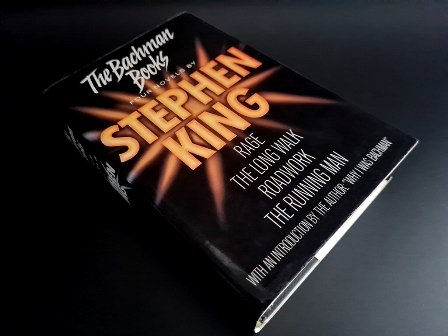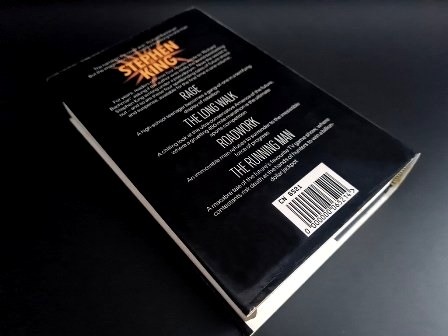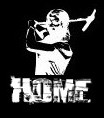
First published back in September of 1977, Stephen King’s novel ‘Rage’ was the first book published under the author’s Richard Bachman pseudonym. The novel was later collected within King’s ‘The Bachman Books’ (1985) omnibus, which contained the first four novels published under this pseudonym.
It should be noted, due to its association with a number of real-life school shootings, King later decided to let the novel fall out of print, making it now one of King’s slightly harder to find releases.
Charlie Decker knew his meeting with the principal at Placerville High School – Thomas Denver – wasn’t going to go well. He’d been on suspension for a couple of month following the incident which saw John Carlosn, the school’s Chemistry-Physics teacher, rushed to hospital.
Now seeing his father’s good friend, Al Lathrop, outside of the principal’s office had only added further fuel to the fire of Charlie’s simmering anger. Seeing the man there reminded Charles of when he was nine years old, on a hunting trip with his father and hunting pals. A memory which restoked the kindles of how much Charlie hated his father. How much this anger within him was all Carl Decker’s fault.
Of course, the meeting with Denver didn’t go well. Largely because Charlie was having none of it. He was done with them all. Done with the school and the self-appointed idiots who didn’t give a shit about anything but looking after their own.
So, Charlie Decker let his gut take over. He had no plan. No grand scheme of what he would do next. How he’d play this all out. For once in his life, he just let instinct take over.
He’d been bringing his father’s old pistol into school since he’d lost the pipe wrench. The pistol was in his locker. After retrieving it, he set fire to the locker, before leisurely making his way to Room 16 where Mrs Underwood was teaching Algebra to the others in his class.
What happened that morning in Room 16 at Placerville High School will change the course of Charlie Decker’s life forever. What happened that sunny morning in May of 1976, will stay with each one of the twenty-four pupils who were in the small classroom, for the rest of their lives.
This is Charlie Decker’s story. This is what happened. This is the outcome of a high school senior’s built-up rage…
Okay, so this is one of those novels that you hear a lot about, and its largely because of the controversy behind the novel’s subject matter. Not that King himself was striving for that type of publicity over the novel at all. Indeed, King himself has since very purposefully let the novel fall out of print, even stating within the foreword to ‘Blaze’ (2007) titled ‘Full Disclosure’ that the novel was “Now out of print, and a good thing”.
So, what of the novel and its subsequent controversy? Well, as always, DLS Reviews will focus purely on the novel itself, rather than its reception. Although, the subject matter does need to be considered in the context of its sledgehammer-like social commentary.
Essentially, we have a young high school senior, who’s struggled with anger he’s built up within himself. A deep-routed anger that’s not at first glance instantly obvious. But instead, a simmering frustration, largely born from a troubled upbringing with his oppressive and abusive father.
The novel isn’t one where it simply tells the story in a flat moment-by-moment manner. Instead, it takes us through that fateful morning, with a large portion of the narrative given over to flashbacks showing us Charlie’s past, which sadly led up to this tragic event. A jigsaw puzzle of prominent moments in his childhood, which form the catalyst to this school shooting.
It’s told through what appears to be the eyes of Charlie, looking back at the events, to try to tell the story as a whole. I say “what appears to be” as there’s a subtle question mark left over exactly who’s telling this story. Although, to explain further would produce a spoiler. So, I’ll shut the hell up over that aspect.
Anyway, we see Charlie shoot a schoolteacher and then another, before he holds the entire class hostage. The authorities are quick to arrive, surrounding the building and communicating with Charlie (and a few of the other pupils) through the school intercom.
But in the main part we have Charlie talking with his classmates. Talking, listening and ultimately exposing parts of their inner lives which have never been said out loud before. It’s a sort of coming-of-age scenario, almost akin to ‘The Breakfast Club’ (1985), only with a troubled teen waving a gun around!
We not only learn about Charlie Decker’s past, but also snippets about the lives from a number of other pupils held hostage in Room 16 that morning. The stories paint a vivid patchwork of teenaged life and the struggles they go through, again with that coming-of-age feel behind it, depicting a sort of real-life grittiness ala ‘The Catcher In The Rye’ (1951). Although, with Charlie, what starts out as a troubled memory of camping with his father, spirals down through a pathway of issues, conflict and simmering anger.
There’s a purposeful feeling of almost voyeuristic detachment that runs through the length of the story. This is perhaps largely driven through it being written ‘after the event’. But then there’s also Charlie’s own detachment from what’s happening. At one point stating, “If I knew what was making me do it, I probably wouldn’t have to”. This echoes throughout the story. A feeling of Charlie being just as helpless and lost in all this as the rest of them in that classroom.
There’s of course more in the novel than what I’ve summarised here. For example, we learn more about a number of the pupils in the room, stories from their past, whereby the culmination of this ‘airing of truths’ leads to the exposure of secrets about one of the pupils who’s a sort of ‘Head boy’ type of character.
All in all, the novel’s an engaging but hard-to-swallow read, which kind of sits on your mind for a little while afterwards. Whether that’s because of its loose links with real-life tragedies that we’ve seen happen since its publication, thereby cutting a bit too close to the bone of reality, or whether it’s such a raw exposure to the consequences of actions, whatever the reason, the story will probably stay with you for a while afterwards, whether you really want it to or not.
The novel runs for a total of 211 pages.

© DLS Reviews









